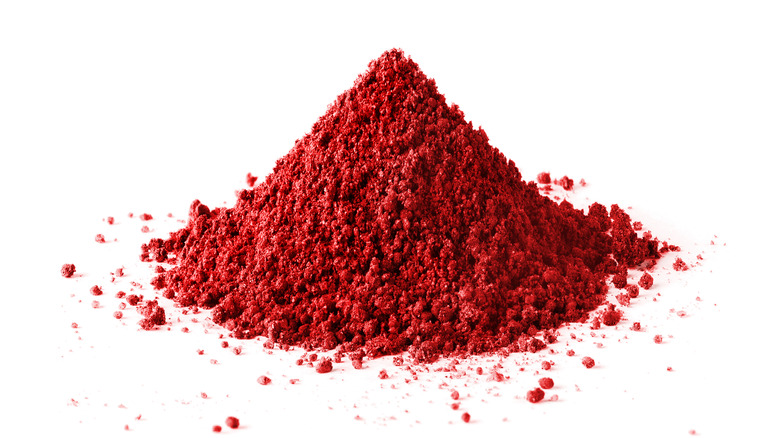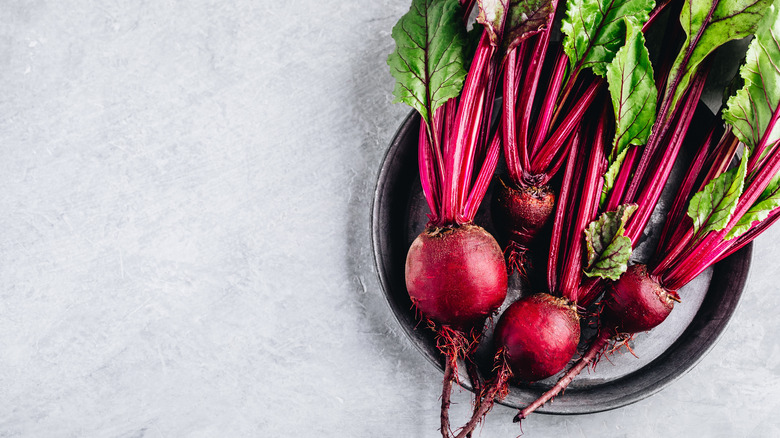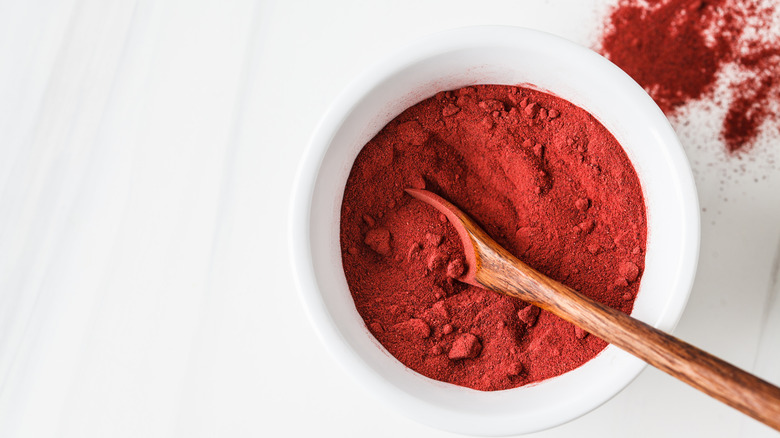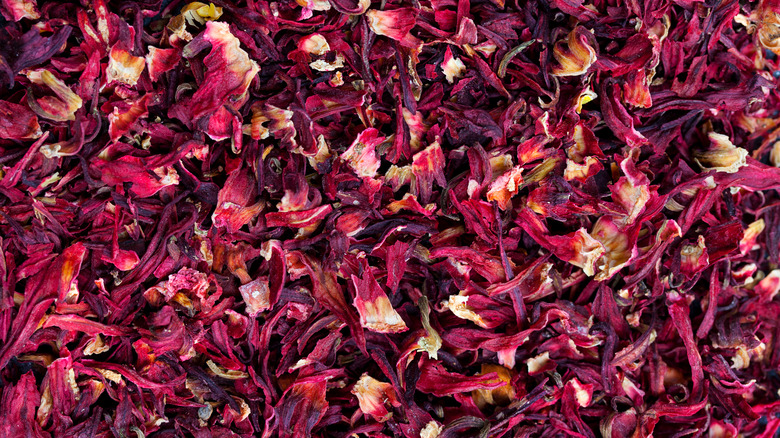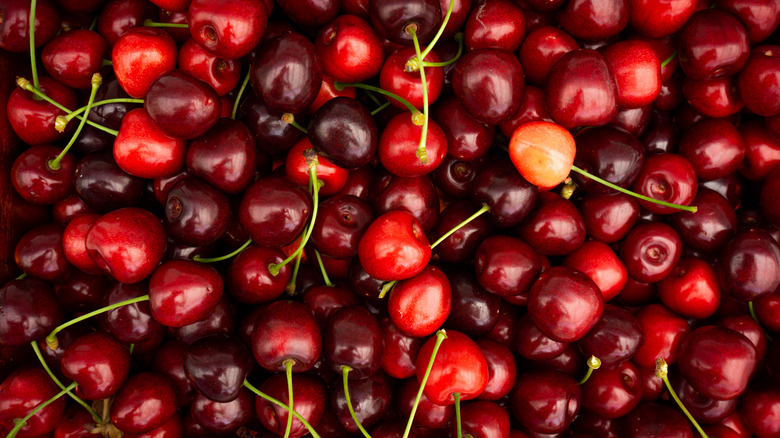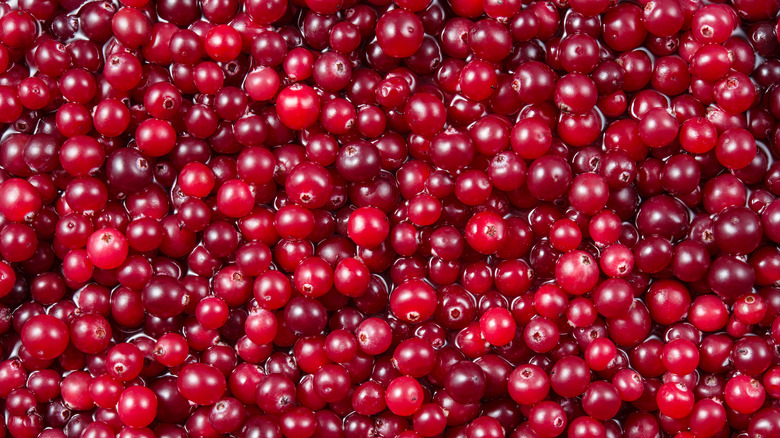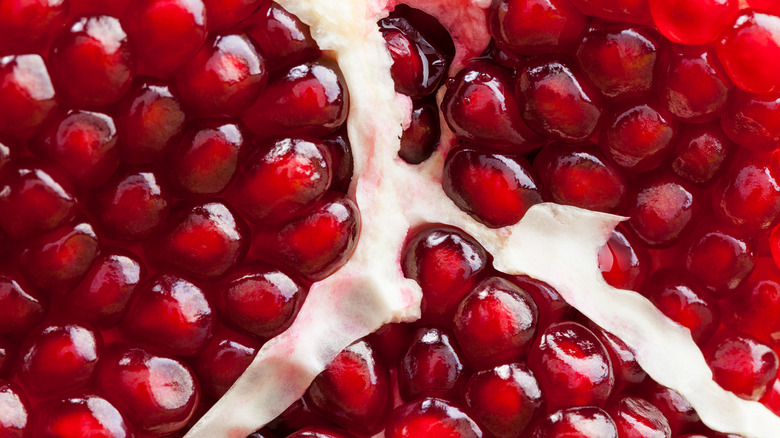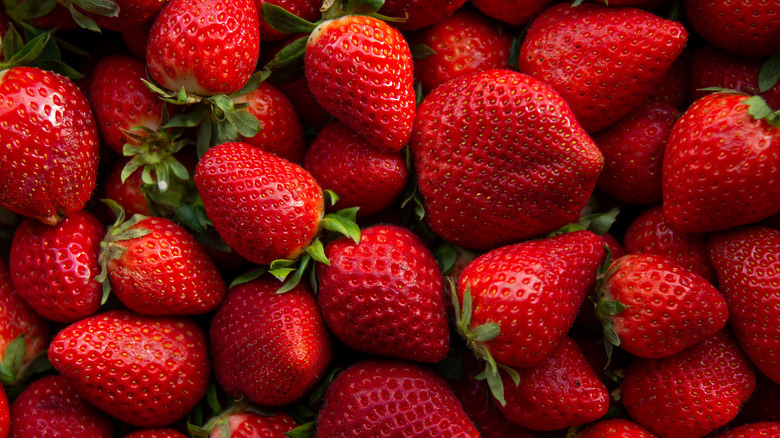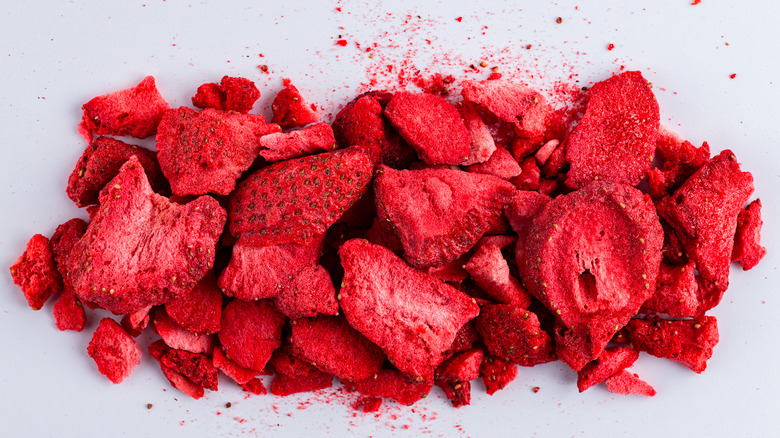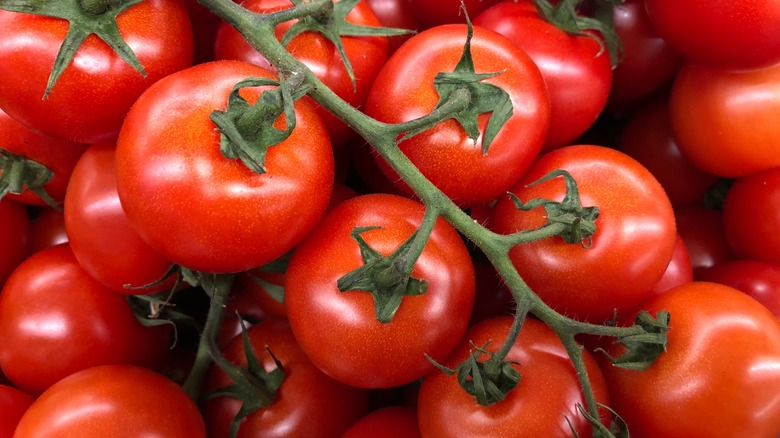9 Best Red Food Coloring Substitutes
Colorant in food has been prevalent throughout history, going back to ancient Egypt, according to the article "Natural Colorant For Food: A Healthy Alternative,"when extracts and wine were mixed into candy to improve product appearance. Even now, food coloring is used in an assortment of food products and home recipes. After synthetic dyes were developed, adding a few drops of blue or a little splash of red made for a more exciting plate. However, we are also in an age where we are starting to take more interest into what actually makes up the food we put in our mouths. The conversation behind using synthetic versus natural has become a controversial one now that several synthetic chemicals have been deemed as unhealthy in the EU, where the subject is heavily explored.
According to ACS ChemMatters, the molecules in food that cause color are called pigments, and there are three common types in plants: carotenoids, anthocyanin, and chlorophyll. Excluding chlorophyll, all of these molecules produce a red pigment when added to other foods. And regarding the controversial health effects brought by the involvement of artificial colorants, a study from the International Journal of Molecular Science states natural pigments also can provide immense health benefits. So, now let's get into our natural food colorants!
Beet juice
Perhaps the most commonly used substitute for red food coloring is beet juice. When baking red velvet cake, red beet juice and puree can be as a replacement for a few drops of red food dye to achieve that iconic rich ruby-red hue, and not to mention add a little twist on the classic flavor. Because beet juice isn't completely flavorless, the overall flavor shifts to a more earthy tone, but in no way does this take away from the sweetness of a slice.
Avoiding the controversial health effects of artificial red food dye, using beet juice actually provides further health benefits, making red velvet cake a — dare I say — healthy choice. According to Medical News Today, beetroots contain a plethora of essential vitamins including, but not limited to, iron, calcium, magnesium, copper and zinc. Beetroot juice is also known to contain antioxidants, according to Medical News Today, which reduces oxidative stress in the body, known as an imbalance of free radicals within the body that in the longterm, which can lead to a development of cancer, heart disease and diabetes.
Beet powder
According to the science journal Molecules, when dried and powdered, beetroot contains a pigment called betanin that can be used as an edible colorant in food and fabric dying processes. This is the only type of colorant, from a group called betalains, that is approved in the usage of food products, cosmetics, and pharmaceuticals, according to "Molecules," in which the beetroot pigment is used to obtain a natural red colorant.
Because this type of natural red food dye substitute comes in a powdered form, it's easy to implement a few spoonfuls to dry ingredients when whipping up a baked good recipe or even combining the powder with steamed milk to create a ruby latte that not only will benefit the aesthetic of your Instagram feed but will also actually bring health benefits into your diet. Similar to beet juice, this natural food coloring can provide your body with several necessary nutrients.
Hibiscus
Most commonly, dried hibiscus flowers are known to be connected with tea, and the process of extracting the floral flavor from the petals in order to produce a refreshing drink. Noting the deep red that these flowers bring when steeped in hot water, the Journal of National Products states that hibiscus flowers are one of the natural sources that contain the pigment, anthocyanin. This is one of the pigments that specifically can cause red coloring in food and fabrics. A research study in the scientific journal Food Research International explains hibiscus was used to color jelly candies a bright red by drying the flowers and using them as a coloring powder and natural dye substitute.
Because of the slightly floral flavor, dried hibiscus flowers work great as a colorant when steeping into drinks, such as tea or cocktails, as well as using dried hibiscus flowers in the powdered form to be implemented with baked goods.
Cherries
Cherries are also one of the foods that contain the color pigment, anthocyanin, which serves as a natural food colourant and replacement for synthetic red food dye. According to Healthline, cherries provide immense health benefits along with the high amount of anthocyanin, which assists in promoting anti-inflammatory processes in the body. The tart flavor of cherries brings an added element to dishes, as well as a rich deep-red hue.
Cherries can be used as a substitute for red food dye in frosting, baked goods, as well as colorful drinks such as cocktails. They can also be used puréed, boiled or even juiced. However, be careful of using too much liquid and take note to not overdo it when using juice or other liquid forms in recipes as adding too much can overwhelm and offset the balance of dry and wet ingredients. This is especially in the case of baked goods.
Boiled cranberries
One of only three fruits native to North America, according to the Cranberry Institute, cranberries found their rise to fame by gracing the tables as a side dish of a typical American thanksgiving feast. And while they certainly deserve their designated place there, according to National Geographic, before cranberries were a part of the thanksgiving meal table, they were a Native American food staple as well as a superfood and had all sorts of uses including medicines and dyes for textiles as well as within cooking.
Due to their bright red hue, cranberries, dried and powdered as well as boiled, can be used as a natural and healthier food colorant alternative. According to the science journal Food Chemistry, when boiled, a natural food colorant that can also be found in flower is extracted called Peonidin. This is a type of anthocyanin, which is the main cause for the notable red color of the fruits and flowers that contain it, and can provide this same color to other baked goods and food types when added as a substitute for red food dye, according to Food Chemistry.
Pomegranate juice
Pomegranate juice is one of those things that you might have sitting in the back of your fridge but always forget to bring out and put to work in the kitchen. Well, here's your sign to bring that jar back to the forefront of your kitchen staples, and if you don't already have pomegranate juice at home, here's a good excuse to race off to the grocery store and grab some.
Known first and foremost for its extreme health benefits which, according to the Advanced Biomedical Research, pomegranates are listed as a natural preventative and even treatment of various diseases and sicknesses including high blood pressure, oxidative stress, and high cholesterol. The Advanced Biomedical Research also notes that the antioxidants found within pomegranate juice are more concentrated than that found within red wine and green tea. Stated in the Analysis of the Coloring and Antibacterial Effects of Natural Dye, pomegranate peel was found and uses as a natural dye, initially for fabrics. Similarly, pomegranates contain pigments that allow for a natural food colorant and provide a rich red hue.
Strawberries
Perhaps the sweetest in nature of all the listed options for a natural red food colorant, strawberries contain the pigment, Anthocyanin according to Food Science and Technology. As stated in Plant Extracts: Applications in the Food Industry, this pigment infuses a brilliant red color when used as a dye for fabric or as red food coloring. According to this publication, the general public and consumers lean more towards a natural solution to coloring dyes in food due to allergies, environmental issues, and toxicity that is connected to synthetic chemicals found within food dyes. Thus, enter strawberries and their anthocyanin compounds, which are responsible for their bright red hue.
With this new era of health-focused eating and growing interest in what makes up the food we eat, food solutions that provide flavor and a colorful diet are growing increasingly popular. Keep in mind when using it as a natural colorant and adding it to a dish, the sweet quality of strawberries will mix up the flavor slightly and turn up the sweetness.
Red freeze-dried fruits
In Trends in Food Science & Technology, freeze-dried whole plants have several functions in fiber, vitamins, minerals, and natural colorants. When powdered, freeze-dried fruits can be easily combined with an assortment of baked goods and meal recipes to serve as an alternative to synthetic red food dye. Especially in recipes where too much liquid might alter the result, powdered freeze-dried fruits can be used. This also includes potential food waste found in fruit peels and various flowers, not only improving health and providing more options for natural food colorants, but also encouraging a holistic sustainable approach to the way that we eat.
When the days get colder, try a different take on a typical hot chocolate recipe by combining a touch of white chocolate (in its solid or powdered form) with a spoonful or two of red freeze-dried fruit powder for a new flavorful and healthy concoction.
Tomatoes
Our predominantly savory friend is on our list of natural red food dye substitutes, and potentially one of the most commonly found ingredients in the average kitchen: tomatoes. Opt for using tomato juice or paste when attempting to switch up the shade of a dish. Easily combined into sauces and soups, tomatoes can be easily used to transition a savory-based dish to lean towards a red color scheme.
According to a study in the journal The Annals of Agricultural Sciences, tomatoes are part of the food group that contains carotenoids, a molecule that delivers a red pigment to its owner and can be infused into other dishes. Even if a savory dish isn't always your thing, why not experiment a bit and add some tomato juice or paste into something sweet? Maybe follow the trends of experimental flavors and use tomatoes as a natural food colorant for ice cream. Tomatoes are technically a fruit after all!
